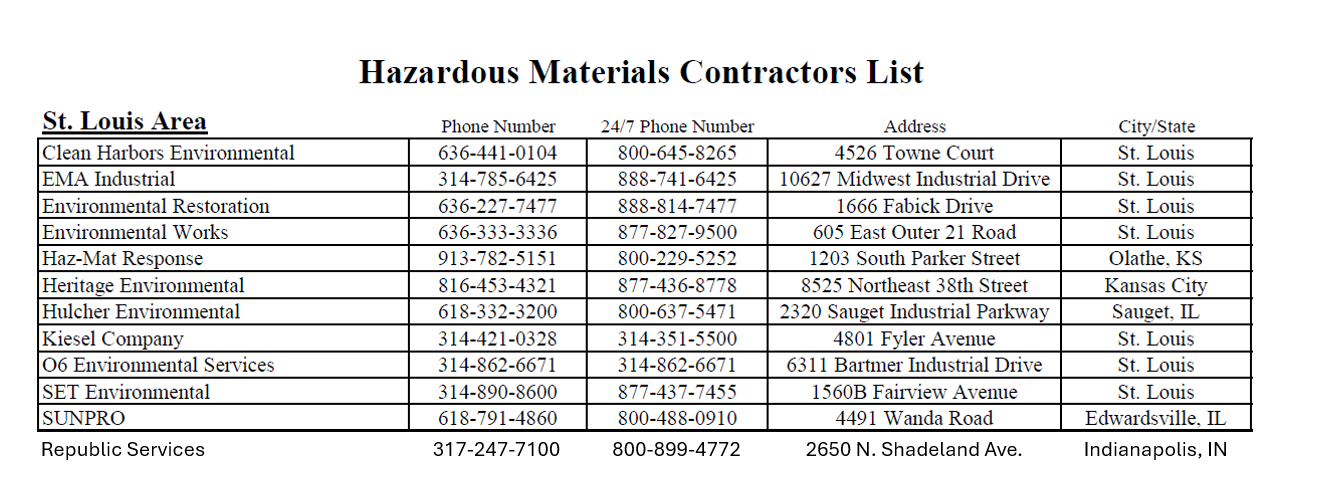These alternative disposal options may be more cost-effective and easier than scheduling a reservation with Saint Louis Household Hazardous Waste Program (HHWSTL).
You can also check out the Recycle Coach here. Type in what you are looking to dispose of and it will list how to get rid of it!
|
Batteries (household) |
Aerosol cans
Aerosol cans that are empty of compressed air and product can be thrown away in the trash can. Please keep aerosol cans out of your recycle bin, as they could cause harm to workers during the sorting process. If there is still product in the can, read the label to determine disposal options.
Automotive Products
Most service stations and quick oil change places will accept used oil, oil filters, antifreeze and other automotive products for disposal. Call your local shop for details. Please note a fee may apply.
*St. Louis City residents may dispose of Automotive Batteries, Motor Oil, and Tires at their transfer stations at no charge. Click for details.
Automotive Batteries
Most stores that sell automotive batteries will accept automotive batteries for recycling. There may be an associated fee for battery recycling.
*St. Louis City residents may dispose of Automotive Batteries, Motor Oil, and Tires at their transfer stations at no charge. Click for details.
Batteries (household)
Check our Recycle Coach here for how to recycle various kinds of batteries.
Rechargeable Household Batteries
The best option, when trying to keep batteries out of landfills, is to choose rechargeable batteries. Depending on the frequency of use, proper handling, and charging, the average AA rechargeable battery can be recharged up to 1,000 times! These rechargeable batteries do contain toxic chemicals and are best kept out of the landfill. Cell phones or rechargeable batteries weighing less than 11 lbs/5kg each can be recycled through the Rechargeable Battery Recycling Corporation Call2Recycle program. Visit Call2Recycle.org to find a drop-off location near you.
Cleaners
Read the label of common household cleaners (ammonia-based cleaners, bleach, disinfectants, drain cleaners, tile cleaners, toilet bowl cleaners, tub cleaners) to determine if leftover product is safe to flush down a sink drain with plenty of water. Never mix chemicals or products and never pour a product down the drain without reading the label first. Click here to see the list of acceptable items that are deemed safe by the Metropolitan Sewer District to flush down the toilet.
Cleaners not listed above, such as solvents and paint thinners, should NEVER be poured down the drain. No HHW of any kind should be poured into storm sewers.
Compact Fluorescent Bulbs and Fluorescent Tubes
Compact fluorescent light bulbs are energy efficient, but they do contain a very small amount of mercury sealed within them (less than what is found in a can of tuna). The best disposal option is recycling. Most home improvement stores have collection stations for CFL recycling. Contact your local store to see if they collect CFLs. Use our Recycle Coach tool here to find a location that will accept CFL light bulbs.
Fluorescent tubes also contain mercury and can be recycled at the following locations:
Lens Masters
fees may apply
11309 Midland Blvd.
Overland, MO 63114
(314) 427-2181
Metro Lighting
fees may apply
Multiple locations
*also accepts light ballasts
www.metrolightingcenters.com/
Batteries Plus Bulbs
fees may apply
Multiple locations
*also accepts light ballasts
www.batteriesplus.com/t/recycling
Latex Paint
Latex paint is not considered hazardous. If the paint cannot be used by others and you do not wish to pay the recycling fee, it is safe to completely dry latex paint and dispose of it in the regular trash.
How to Dry Latex Paint:
- In the can
- Add an absorbent to leftover paint, such as Oil Dry, clay-based cat box filler (non-clumping), sand, or sawdust.
- Let the residue dry completely before disposing with household trash.
- Check with your hauler about any restrictions.
- In a cardboard box
- Line a cardboard box with newspaper.
- Pour some absorbent material on the newspaper.
- Pour a small amount of unwanted paint atop the absorbent material.
- Stir the mixture and coat all of the absorbent material well. Add more absorbent material or paint as needed. Be sure to remove all remaining paint from the can. Use additional boxes if necessary.
- Set mixture aside to dry in a well-ventilated area away from heat, children, and pets. Allow several hours or days to dry completely.
- Once the paint mixture has dried completely, you can place it in your household trash along with the paint can.
Mercury Containing Devices
Thermostats containing mercury can by recycled at no charge through the industry sponsored Thermostat Recycling Corporation. Visit their website for information and to find participating locations in St. Louis.
The Missouri Department of Natural Resources occasionally sponsors mercury collections. Visit their website for information.
Smoke Detectors
The Post Office has a handy chart on how to properly dispose of smoke detectors. It can be found here
Commercial/School/Non-profit/Unacceptable Item hazardous waste disposal
Check the EPA website here to learn more about hazardous waste disposal
Check here for disposal options for items that are not accepted through our program
See the list below of commercial hazardous waste experts to contact for disposal options

